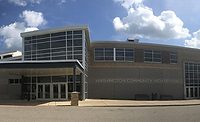As more state and federal grants and funding becomes available for school improvements and security installations, some K-12 school districts are taking advantage of these opportunities to better guard students, staff and district property. One way in particular is through video surveillance.
According to Josh Ennis, Director of Security for Hilton Central School District in New York, additional funding from the New York State Government has fully reimbursed the school district for its investment in video surveillance and other security measures, enabling the district, and Ennis, to double the number of security cameras on the district’s six buildings, which includes installing cameras at the intersections of hallways and implementing visitor controls at the schools’ entrances.
At the time, the district’s 10-year-old analog security system was no longer able to provide adequate recordings to investigate and resolve incidents, so over three years, the PreK-12 district completed a phased upgrade to a unified security platform – Genetec Security Center – that connected both new IP cameras and encoder-enhanced analog cameras, as well as access controls.
“We’re on a perpetual state of lockdown once the school day starts,” says Ennis. “All of our exterior doors are automatically locked, and access control is integrated to our intercom system.” This enables a staff member inside the school to review who is standing outside with video surveillance when a visitor pushes the intercom button, and then he or she can communicate with the visitor, verify their identification and automatically let them inside.
The school staff is also saving time through visual tracking features – following a person throughout the building from one camera to the next instead of manually hunting through a dozen cameras’ footage to reconstruct an incident.
“There are hard dollars and soft dollars that we save,” says Ennis. “Hard dollars are saved by reducing meantime to resolution for incidents. What used to take hours now takes minutes; we can easily calculate that if a principal saved four hours of time then the district effectively saved ‘X’ amount of money. Insurance claimed that were identified as false (after video surveillance aided investigations) is a hard dollar amount. Because it’s an IP solution, I was able to save during installation by leveraging my existing infrastructure. Soft dollars is more along the lines of parent comfort and trust in the safety of their children. You can’t measure that with money, but the value is immense.”
In North Carolina, the Roanoke Rapids Graded School District is also seeing savings in time and money when it comes to investigations after installing surveillance cameras. The high school campus is located in the middle of the 16,000-person town, and students frequently ride bicycles or walk to school. The perimeter is open, and there are dozens of entry points to the district’s school buildings. School administrators had tested and looked at video surveillance for years, but recently students, parents and faculty alike were concerned about threats and violent incidents in schools around the country, leading the district to invest in an IP-based video surveillance system from WatchNet Inc. and North Carolina-based integrator AAA Security.
Roanoke Rapids High School Principal Tammie Williams says that the video surveillance system has freed up hours of school resource officers’ (SRO) time on investigations. When they used to have to call in six to 10 students to determine what happened in an incident, now they can access the video feed – even remotely from a laptop – and get a clearer picture of an event, instead of having to rely on “he said, she said” information.
Robbie Clements, Director of Facilities and Operations, says that “There is very little ‘unknown’ now in the schools; we can easily go back and uncover the real events and positively identify any suspects. We don’t have to guess anymore.”
Clements worked with AAA Security to plan out the camera installations, especially in regards to the Senior Building at the high school, which was built in 1920 and is on the National Register of Historical Places. After obtaining approval for the project, two small cameras were installed on the front of the building, and pan-tilt-zoom cameras were installed on the surrounding school buildings to keep a better eye on the historical property.
If anything does happen, however, one of the district’s SROs can look through the two months’ worth of recordings, select the pertinent period, put the recording on a thumb drive to produce the video in court.
“The video cameras ensure fidelity in our school,” says Williams.
For Plattsmouth Community Schools in Nebraska, enhancing surveillance started with asking for help. In the spring of 2014, the Plattsmouth school district called on Prime Communications to perform a security audit, which led to a plethora of recommendations, including creating a district safety plan, training staff, and adding cameras to better protect the schools’ perimeters.
“Our old security system was so old, we really had to prioritize where to start,” says Anthony Nabower, Technology Director for Plattsmouth Community Schools. “We wanted to focus on the perimeter first and then go back to mitigating students smoking in the bathrooms and altercations in the hallways and common areas.” The system uses Genetec’s Security Center platform to monitor both access control and approximately 70 new Axis Communications IP cameras. Secondary areas of priority include lunchroom areas, stairwells and hallways. The district is planning on adding several new cameras per year, mainly in hallways, with the primary goal of being able to track a potential intruder’s movements throughout the school, Nabower adds.
Nabower also worked with the Plattsmouth Police Department captain to determine the best location for cameras and to develop a policy to share access to the schools’ cameras in the event of an incident. The system logs every person who logs in, so the district can mitigate any risks of abuse of system access privileges.
While surveillance and technology are important, Nabower says that “having a safety plan was one of the biggest concerns from our staff. Our plan is emphasizing drills and communication, and having that plan in place is more important than the number of cameras installed.”






